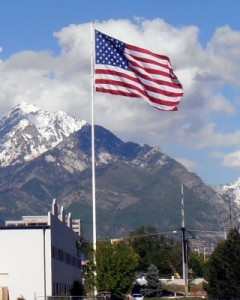Why Do We Fly Flags at Half-staff?
John M. Hartvigsen
The idea that we fly flags at half-staff to honor individuals who have died has grown tremendously during recent years. Nevertheless, the centuries old tradition at sea and on land developed as a way to show grief, sorrow and mourning at the death of a fellow.
While this may seem to be a minor distinction, the emphasis on mourning for a person has great importance. We lower flags to half-staff when members of our military are killed in battle, and for grieving family and friends the display symbolizes that they do not mourn alone.
Likewise, a flag draped casket with the flag ceremoniously folded and presented to the next of kin bespeaks that the fallen sacrificed life itself in a cause greater than self and receives “the thanks of a grateful nation.”
These symbolic acts comfort and lessen grief, but the emphasis is on individuals.
There has also been a growth in the United States of lowering flags to half-staff to observe events many years after they took place. For example, the attacks on Pearl Harbor resulted in the battle field death of 2,403 U.S. military and civilians. Certainly the nation was plunged into mourning; in 1994 however, more than half a century after the “Day of Infamy,” Congress created Pearl Harbor Remembrance Day, which specified the lowering of flags to half-staff on the date of that national observe. After the lapse of five decades, the immediate grief and mourning was replaced by observance of an anniversary.
As instances of half-staff display has in recent years increased dramatically to a point that has attracted considerable criticism. An article published in USA Today noted that on any given day, the United States Flag is officially flying at half-staff somewhere in the nation. In excess the practice loses impact and meaning. One quoted individual stated that when we need to ask why the flag is at half-staff, it has lost all meaning.
How may we fix the problem? While change will not be easily brought about, but here are some ideas
- Return to the original Flag Code’s practice of flying the flag at half-staff for only one annual observance of Memorial Day and then only until noon.
- Honor annual days of remembrance by encouraging display of the flag to honor the event. For military installations, the larger Garrison Flag could be flown honoring the observance.
- Adopt the practice of displaying three sizes of flags: smaller storm flags flown during inclement weather, regular sized flags for display on any day and larger special observance flags to be flown on holidays and other observances.
- Shorten the days of half-staff display for public officials to be observed from death until burial. For some individuals, half-staff display on the day of the funeral and burial.
- Recognition that civilian organizations, businesses, schools and private individuals my display the flag at half-staff on their properties to show mourning that affects them.
- Fly the flag at half-staff during services on the flagpole adjacent to any facility where a funeral is conducted and at the cemetery during the burial ceremonies.
- Recognize that official proclamations issue upon the death of an honored individual may include half-staff instructions but are not required.
These modifications are supported by tradition, by practice in other countries and finding a common-sense approach to show mourning and give honor as appropriate.
Fly the flag to honor but fly the flag at half-staff to express sorrow and show mourning.


